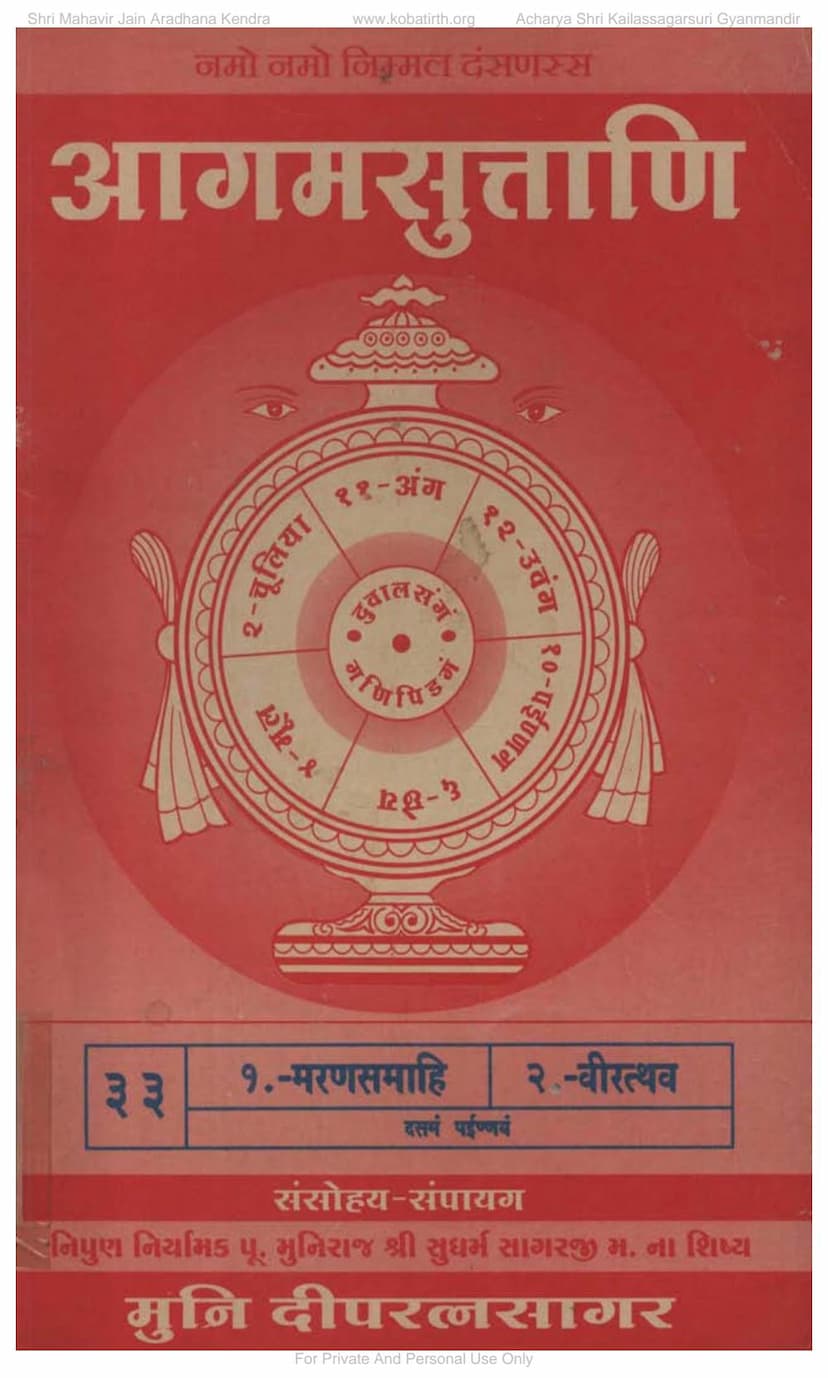Agam 33B Viratthava Painnagsutt 10B Moolam
Added to library: September 1, 2025

Summary
Here is a comprehensive summary of the provided Jain text, focusing on the content and its context:
The provided text is a scanned portion of a Jain scripture publication. Specifically, it is identified as:
- Book Title: Agam 33B Viratthava Painnagsutt 10B Moolam
- Author(s): Dipratnasagar, Deepratnasagar (likely the same person)
- Publisher: Agam Shrut Prakashan
The text is from the Shri Mahavir Jain Aradhana Kendra and is associated with Acharya Shri Kailassagarsuri Gyanmandir. The material is explicitly marked for "JAIN EDUCATION INTERNATIONAL FOR PRIVATE AND PERSONAL USE ONLY."
Overall Content and Purpose:
The document appears to be a detailed, scholarly edition of a Jain Agam (scripture). The primary focus of the provided pages is on "Viratthava" (वीरत्थव), which is the tenth Painnagsutt (पईण्णय), being the 33rd Agam in the series (or volume 33B). "Viratthava" translates to a hymn or eulogy in praise of Lord Mahavir, the 24th Tirthankar.
Key Sections and Information:
-
Title and Attribution (Pages 1-2):
- Clearly states the title, authors, and publisher.
- It is dedicated to "Shri Anand-Kshama-Lalit-Sushil-Sudharmasagar Gurubhyo Namah," indicating reverence for a spiritual lineage.
- Mentions the price of a 45-Agam set, suggesting this is part of a larger project to publish all Agams.
- Lists printing and composition details.
-
Financial Supporters (Pages 3-5):
- A significant portion of the document is dedicated to listing "Aarthik Anudaan Daata" (આર્થિક અનુદાન દાતા), meaning financial donors. This indicates that the publication of these scriptures is a community effort, supported by various individuals and Jain sanghs (communities/organizations).
- The donors are listed with their names, often including family members or associated organizations (e.g., Jain Sanghs in Vadodara, Madras, Ahmedabad, Surendranagar, Nanderbar, etc.).
- Many donations are made in memory of departed individuals or in connection with religious observances like Chaturmas, Paryushan, or specific austerities (tapas).
- The lists highlight a strong community involvement in preserving and disseminating Jain scriptures.
-
The "Viratthava" Hymn (Pages 6-10):
- This is the core of the scripture presented. Page 6 shows the beginning of the text with "वीरत्थओ" (Viratthava).
- The text is in Prakrit (likely Ardhamagadhi, the language of the Agams), with a title indicating it's a "Ganth" (collection) of the "Viratthava."
- The subsequent pages (7-10) contain the Prakrit verses (slokas or sutras) of the Viratthava, along with their numbering and explanations or continuations.
- The hymn is structured around praising Lord Mahavir by enumerating his various epithets and divine qualities. It explains the meaning and origin of names like:
- Arhat (અરહંત): One who has conquered inner enemies.
- Arihant (અરિહંત): The destroyer of enemies.
- Arhasi (અરહોસિ): Worthy of worship.
- Jin (જિણ): The conqueror.
- Vir (વીર): Heroic.
- Mahavir (મહાવીર): Great Hero.
- Param Karunik (પરમકારુણિય): Supremely compassionate.
- Sarvagna (સર્વજ્ઞ): Omniscient.
- Sarvadarshi (સર્વદર્શી): All-seeing.
- Trikalvit (તિક્કાલવિઉ): Knower of the three periods (past, present, future).
- Nath (નાથ): Lord, Master.
- Tirthankar (તિત્થયર): Founder of a religious order.
- The hymn systematically breaks down these names and connects them to Mahavir's virtues, such as conquering passions, being free from impurities, possessing infinite knowledge, and being the source of liberation.
-
Explanatory Notes and Catalog (Pages 7, 13-15):
- Page 7: Provides "Suchanapatra" (सूचनापत्र - Notice/Instructions) on how to read the scripture. It explains the numbering conventions (continuous serial number, Hindi numbering for sutra/gatha, English numbering for commentary, indication of missing text).
- Page 13: Lists other published works by Agam Shrut Prakashan, including various "Abhinav" (new) series on Jain philosophy, rituals, almanacs, and critically, the entire set of 45 Agams published by them. This confirms the context of this publication within a larger project.
- Page 14: Details the contents of "Parishisht" (Appendices) for volumes 45-49 of the Agams, outlining planned future publications like indexes of subjects, special words, personal names, and gathas. This shows the scholarly depth and commitment to making the Agams accessible.
- Page 15: Mentions a "Pradhan Arthik Anudata" (Chief Financial Donor) and reiterates the publisher.
Significance:
This document represents a dedicated effort to preserve and disseminate the ancient Jain scriptures in a scholarly and accessible format. The "Viratthava" itself is a devotional hymn that glorifies Lord Mahavir by exploring the profound meanings of his various names and attributes. The extensive list of donors underscores the communal importance placed on these texts within the Jain tradition. The supplementary information about other publications and future projects highlights the publisher's commitment to comprehensive Jain literature.